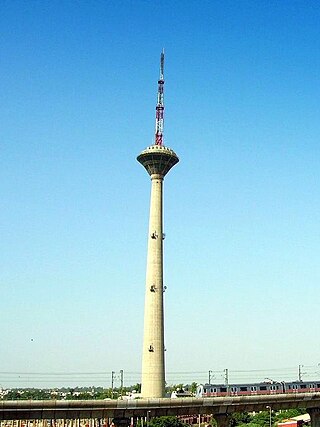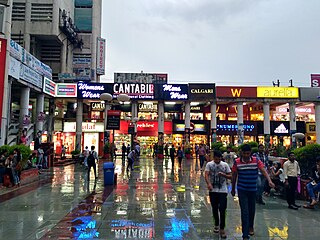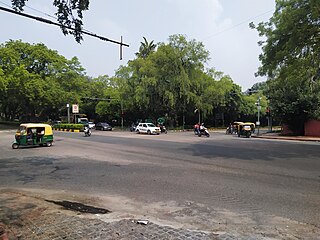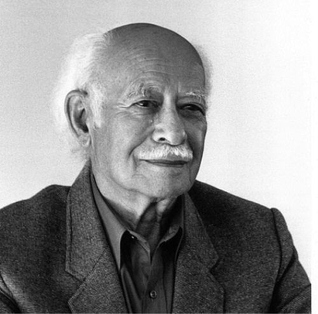
Pollok is a large housing estate on the south-western side of the city of Glasgow, Scotland. The estate was built either side of World War II to house families from the overcrowded inner city. Housing 30,000 at its peak, its population has since declined due to the replacement of substandard housing with lower-density accommodation. As of 2021, the population was recorded at 81,951 people.

Khan Market is a shopping district and retail market in New Delhi, India. It was established in 1951 by the newly constituted Republic of India's Rehabilitation Ministry to give economic opportunities to refugees of the Partition of India, especially those from the North West Frontier Province (NWFP), now Khyber Pakhtunkhwa, a province in Pakistan. Many such refugees had arrived in the Delhi region. It is named after Khan Abdul Jabbar Khan, also known as Dr. Khan Sahib, who was the Chief Minister of NWFP from 1945 to 1947, and who had helped many refugees to escape without harm. Khan was the elder brother of the Pashtun- and Indian-freedom activist Khan Abdul Gaffar Khan. In 2019, Khan Market was rated as the world's 20th most expensive commercial street by Cushman & Wakefield.

Santacruz or Santa Cruz is a suburb of Mumbai. The Santacruz railway station on the Mumbai Suburban Railway, the domestic terminal (T1) of the Chhatrapati Shivaji Maharaj International Airport, and one campus of the University of Mumbai, are all located in Santacruz (East).

Pitampura is a residential area in North West Delhi district of Delhi, India. It is located adjacent to Rohini. It is a planned neighbourhood developed by the Delhi Development Authority in the 1980s and Pitampura TV Tower, was built in 1988. Dilli Haat Pitampura is also situated near the TV tower. Situated in west Delhi, it is an upscale residential, commercial and retail centre. The area is encompassed between Outer and Inner Ring Roads, NH-1 and Rohtak Road. It has two wards, Pitampura and Pitampura North, under the Rohini zone of Municipal Corporation of Delhi.

Basaveshwaranagara, also known as Basaveshwaranagar, Basaveshnagara or Basaveshnagar is a largely residential neighbourhood in the west of Bengaluru, Karnataka, India. It is located to the west of Rajajinagara and is sandwiched between the localities of Mahalakshmi Layout to the north and Vijayanagara to the south, spread across multiple sub-localities, three assembly constituencies and seven Bruhat Bengaluru Mahanagara Palike (BBMP) wards. The area of Basaveshwaranagara is often considered West of Chord Road as it lies to the west of Chord Road, an arterial road in the western part of Bengaluru.
Sainikpuri is a residential neighbourhood in the northeastern part of Hyderabad City. It falls under Kapra mandal of Medchal-Malkajgiri District, and is currently administered under GHMC East Zone. It started as a co-operative housing society venture for retired army personnel, but now has houses which belong to other defence services as well as civilians. Late Brig M. K Rao, Late Brig S.N.Docca and Late Lt. Col. Tiwari Singh were the first few to have got plots in the society and had a vision to develop the colony into an elite area. The housing plots originally allotted to the members of the Sainikpuri co-operative society were of the size of 700–1,000 square yards each. Owing to this reason, most residences have large lawns and gardens. Roads are well laid and numbered. Avenues are lined with a variety of flowering and fruiting trees, and are ideal for morning and evening walks. The sprawling cantonment area, as well as The College of Defence Management (CDM) which is a premier establishment of the Indian armed forces, are in the vicinity of Sainikpuri. The old buildings are now slowly giving way to multi-storied apartments, and it is becoming a costlier affair to acquire living space in this area.

Janakpuri is an affluent neighborhood in the South West district of Delhi, India. It is located near the Delhi Cantonment area and is accessible by road and Delhi Metro via multiple lines.

Lodi Road in New Delhi, India, is named after the Lodi Gardens located on it. Two Mughal mausoleums, Humayun's Tomb and Safdarjung's Tomb, lie at the eastern and western ends of the road respectively. A number of cultural, educational, and international institutions line the road. The Jor Bagh metro station lies under Aurobindo Marg near its intersection with Lodi Road. Also located near it are Lodi colony and Lodi Estate built during British Raj in 1940s, and Lodi Road Institutional Area.

Kamla Nagar is a residential and commercial neighbourhood in North Delhi, India. It is one of Delhi's major shopping centres.
Dwarka is a neighbourhood located in Southwestern edge of Indian Capital New Delhi in South West Delhi district of the NCT of Delhi. The district court that functions under the Delhi High Court for South West Delhi is located in Dwarka.

Sir Walter Sykes GeorgeC.B.E. was an English architect active in India during the first half of the 20th century, most known for being part of the team of architects who designed New Delhi, the new capital of India, from 1911-1931.

Moti Bagh, a residential locality in South Delhi, was developed in 1950s to house Government employees. This locality, with many trees and parks, is divided into South Moti Bagh and North Moti Bagh.
Nizamuddin West is an upscale residential locality, conveniently located south of India gate. It is a historically busy neighbourhood in Central Delhi and has many parks and trees. It sits in the green lung of delhi, with Humayun's Tomb, Sunder Nursery and Delhi Golf club around it. The popular landmarks around it are Khan Market, Lodi Garden, Oberoi Hotel. It is well connected with Public transport.

Joseph Stein was an American architect and a major figure in the establishment of a regional modern architecture in the San Francisco Bay area in the 1940s and 1950s during the early days of the environmental design movement. In 1952, he moved to India and in 1955 was tasked with the planning of Durgapur in West Bengal, India along with Benjamin Polk. He was commissioned with this task in order to facilitate the establishment of Durgapur Steel Plant later on in 1959 followed by the Durgapur Steel City and Township. He is noted for designing several important buildings in India, most notably in Lodhi Estate in Central Delhi, nicknamed "Steinabad" after him, and where today the 'Joseph Stein Lane', is the only road in Delhi named after an architect. He is also famous for being the architect of the scenic Indian Institute of Management Kozhikode's campus. The Government of India awarded him the fourth highest civilian award of Padma Shri in 1992. His works remain even more relevant in the modern context as need for sustainable and humane architecture is felt.
Madhavaram Milk Colony is a neighbourhood in northern Chennai, a metropolitan city in Chennai district in the Indian state of Tamil Nadu.

Green Park is an upscale affluent neighborhood in South Delhi, India. The locality is divided into two parts i.e. Main and Extension. The neighbourhood registered a 4.4% growth in residential sales and was featured alongside Greater Kailash, Defence Colony, Vasant Vihar and Anand Niketan in the 2019 edition of Knight Frank's quarterly report on prime luxury residential properties in various megacities around the globe. Property rates have always been high in this colony due to the numerous facilities available. Builder floors and independent villas cost anywhere between INR 6–70 crores in this colony. Rental rates are also very high making this residential area among the most expensive pin codes of New Delhi.
Defence Colony is a neighbourhood in Delhi. It was built in the 1960s for veterans of the Indian Armed Forces. It serves as the administrative headquarters of the South East Delhi district of Delhi.

Dr. B. R. Ambedkar University Delhi, formerly Bharat Ratna Dr. B. R. Ambedkar University Delhi and Ambedkar University Delhi, and simply AUD, is a state university established by the Government of the NCT of Delhi through an Act of the Delhi Legislature. The university began functioning in August 2008. It is a Unitary non-affiliating University whose main focus is on undergraduate and postgraduate studies and on research in the Humanities and the Social Sciences. It is completely funded by the State Government of the NCT of Delhi. The university is now declared eligible to receive Central Government Assistance. The university has been graded 'A' by National Assessment and Accreditation Council. It is named after the polymath B. R. Ambedkar, the architect of the Indian Constitution and one of the founding fathers of India.
Andretta is a village and an artists' colony in Himachal Pradesh. The artists' colony was established in the 1920s, when Irish theatre artiste and environmentalist, Norah Richards, shifted here from Lahore. Near Palampur in the Kangra District, with Dhauladhar range of the Himalayas as a backdrop, Andretta over the years has attracted many noted artists, theatre practitioners, painters and more recently potters. Two of the people who became associated with it early on were painters Sobha Singh and B. C. Sanyal.














